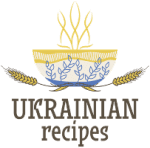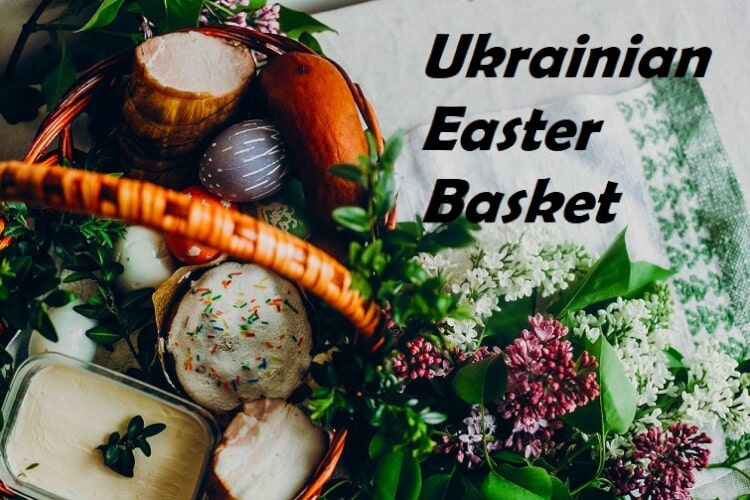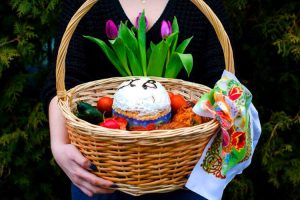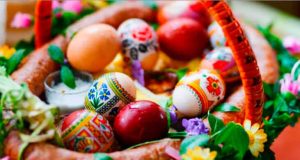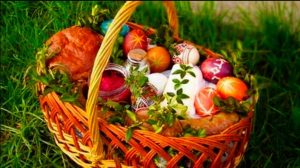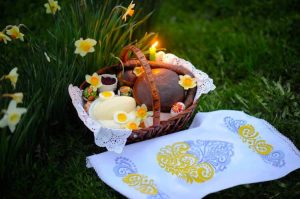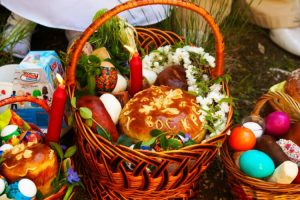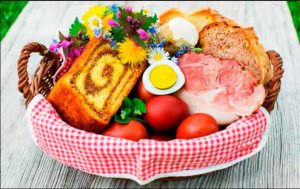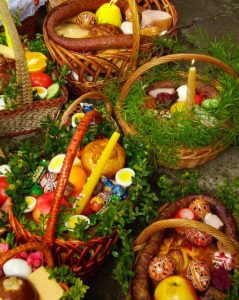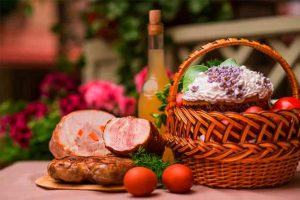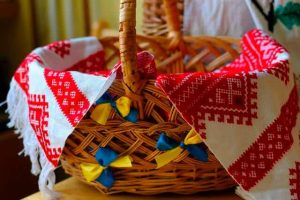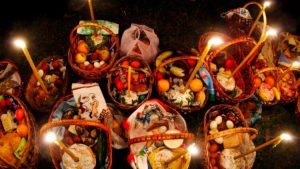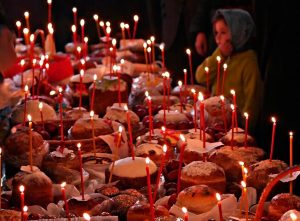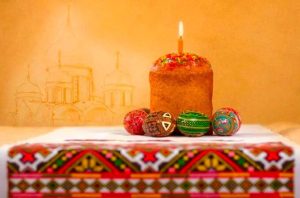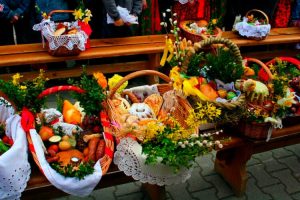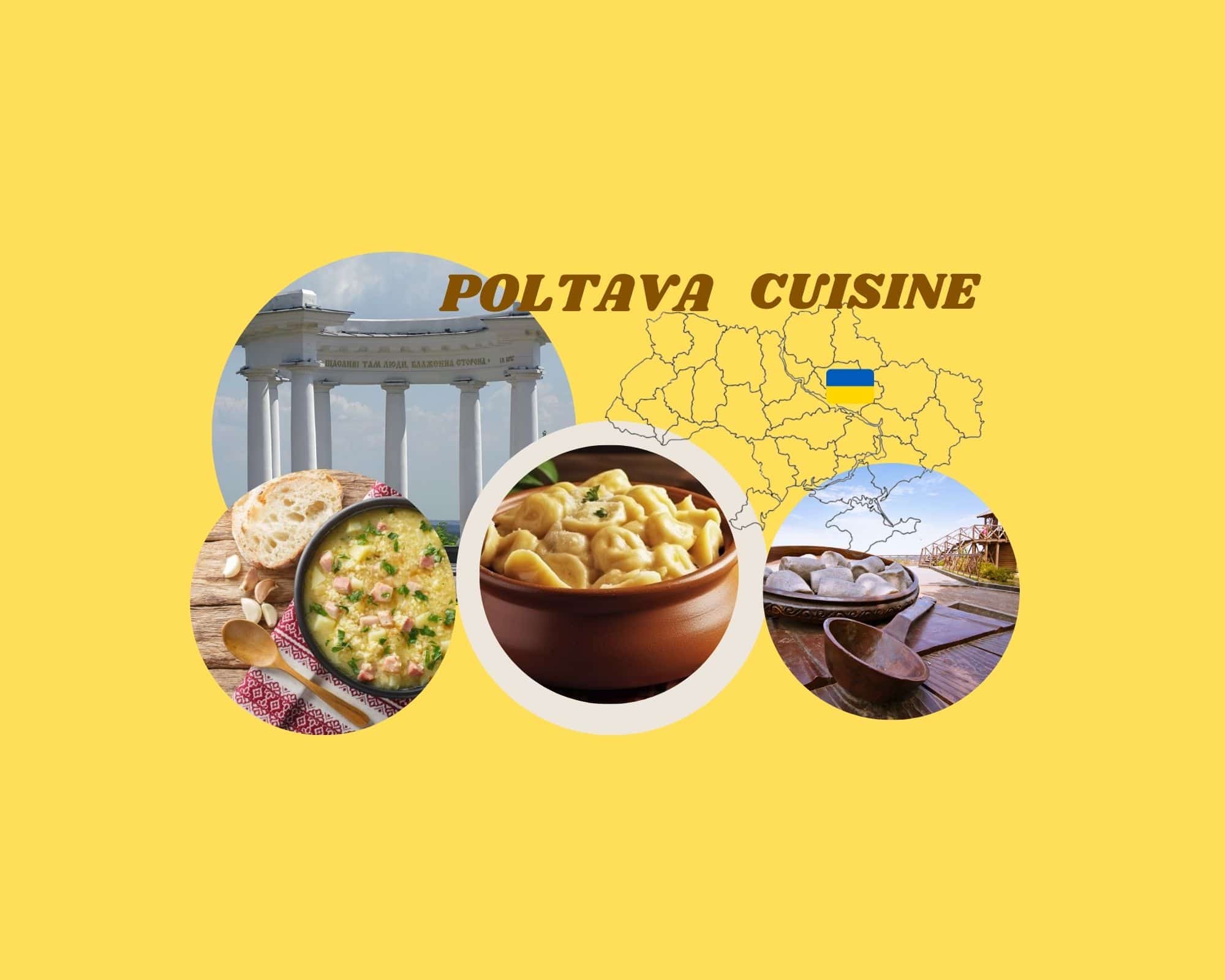Easter is coming soon – the day when Christians celebrate the Resurrection of Jesus Christ that happened on the third day after his death. On the night of the Resurrection of Christ, the festive church service is held, and people bring Easter baskets with Easter bread, eggs, and other products to the church.
In this way, the church blesses Christians after a long fast to eat again dishes containing meat or milk products.
The tradition of filling the basket varies in different regions of Ukraine. People put different products in the basket not accidentally. Every product has its own symbolic meaning.
“There are no clear church rules regarding what should be put in the basket. This tradition was established among people for years. Consecrated by time, it was perceived by the church.” Bishop Yevstratii of the Ukrainian Orthodox Church of the Kyiv Patriarchate notes.
“There are prayers for the blessing of lambs, meat dishes, as well as eggs and dairy foods in the prayer book,” adds Ihor Yatskiv, a spokesman of the Ukrainian Greek Catholic Church.
Easter bread
Easter bread is the traditional food that is always brought to the church. Every goodwife has her own recipe of the Easter bread yet all of them have a round shape symbolizing the sun. It is believed that the best Easter bread is the one cooked in peace and only with good thoughts.
Easter eggs
Easter eggs are put next to the Easter bread into the basket. There are many types of Easter eggs, including pysanky (eggs decorated with traditional Ukrainian folk designs using a wax-resist method), krashanky (one-color dyed eggs), driapanky (eggs with a design scratched on their shells).
“In Halychyna (Galicia), both krashanky and eggs without a shell were put in a basket, while in central Ukraine whole eggs were blessed,” says Halyna Oliinyk, the senior researcher of the scientific and educational department of the Ivan Honchar Museum.
In central Ukraine, everyone had their own krashanka. In Halychyna, one egg was divided among all members of the family. Traditionally, krashanky were primarily colored in red, according to the legend about Mary Magdalene, who came to the Tiberius, the second emperor of Rome, with a red krashanka to announce the Resurrection of Christ.
Meat dishes
The tradition to put meat dishes in the basket is generally referred to the Old Testament Easter: on this holiday people were eating a sacrificial lamb in commemoration of how the Lord commanded to slaughter the lamb and to mark the doors with its blood, so that the angel of the wrath of the Lord would bypass the dwellings of the chosen people.
Lamb is a prototype of Jesus Christ who saved all people from the power of death with his blood. This is the sacrifice of Jesus Christ, whom John the Baptist calls the Lamb of God who accepts the sins of the world. In Halychyna people put smoked sausage and ham in the Easter basket. In central Ukraine, it was more common to put baked meat, sausages, and salo (bacon/salted pork fat).
Dairy products
Milk foods are the products that are not created by a man but are gifted by Mother Nature. Cheese and butter symbolize the sacrifice and tenderness of God, which you should wish as a child wishes the mother’s milk. By tradition, dairy products are put in small containers and are covered with lids where crosses are drawn.
Horseradish
Horseradish symbolizes the strength and invincibility of the human spirit after performing the sacrament of Confession. This powerful root can give a person faith in the Resurrection of the Lord Jesus Christ.
The horseradish root which is especially widespread in Western Ukraine, in the words of Bishop Yevstratii, refers to the Old Testament. During Easter, Jews had to eat foods seasoned with bitter spices to remember the bitterness of slavery in Egypt.
There is a legend that someone tried to poison Christ with horseradish roots that were believed to be deadly because of their bitterness. However, this plant, as a natural antiseptic, on the contrary, is beneficial and helps digestion.
Salt
Salt also was always blessed. It symbolizes the quality of communication between God and people who need to keep the purity of their heart to imitate Christ. In addition, salt is considered to be a protective amulet. Ukrainians meet guests with bread and salt and took a piece of salt with them when they went on a journey.
Evergreens
The basket was also obligatory decorated with an evergreen plant – as a symbol of eternal life and immortality. In central Ukraine as well as in Stryishchyna, creeping myrtle (periwinkle) was mostly used, while in the Lviv region and Boikivshchyna – people used boxwood.
Additional items
Some Ukrainians also put into the basket poppy seeds which were used to cook Christmas kutia. Millet, pyrizhky (patties) with cabbage, liver, and apples were blessed in central Ukraine. In Boroniava (Carpathian region) people also put a boiled or roasted cock. As believed, the cock was the first who t informed people that Christ was resurrected from the dead.
Wine
As for wine, priests do not encourage to bring it to the church/temple, although it has a clearly defined Biblical symbolism.
Christ calls himself a vine, and his disciples he calls branches. As branches without a grapevine can’t bear fruit themselves, so people who are not combined with Jesus Christ can’t bring spiritual fruits. The wine is used in the most important sacrament of the church – the Eucharist, during the Communion.
“The first miracle made by God during the wedding feast was when he turned the water into wine. You need to understand that God is with us not only in sorrow,” says Bishop Yevstratiy. You have to understand that meat and milk products you bring to the church are blessed to eat after the Lent. And thus, there should be little food.
Yet, there is no prayer that blesses wine. This can be explained by the fact that “during some fast days, alcohol is not forbidden (on Sundays and during holidays in the fasting period, often the Annunciation), and the prayer blesses those dishes that we are not allowed to eat during the fast,” explains Hegumen Lonhin.
Of course, no one prohibits to drink alcohol on Easter, but it is not recommended to bring wine, vodka and the like to the church.
Embroidered towel
The basket is covered with a beautiful embroidered napkin or towel symbolizing life and destiny. This is the wealth of threads woven with love and intelligence. During the blessing, people put a candle in the basket which reminds of Jesus, who is the Light for the world. A candle is a light that comes out between people.
What is forbidden to put in the Easter Basket:
– jewels, documents, money and other material things;
– horilka (Ukrainian vodka usually distilled from grain), cognac, samohon (moonshine) and other alcohol;
– blood sausage and other products made from the blood of animals;
– fruits and vegetables are also not recommended to put in the basket as they were allowed to be eaten during the fast;- There is an opinion that blessed products need to be cut with a blessed knife. This is prejudice.
When the food is blessed?
In different churches and temples, the time for blessing may vary. One church can bless Easter Baskets already on the pre-holiday Saturday, and the other – right on Sunday. The Easter liturgy in the church lasts all night and is therefore called “all-night”.
At about 4:00 an Easter procession takes place. Then priests change dark clothes to light and start to bless Easter baskets. They proclaim the words: “Christ is Risen!” (“Khrystos Voskres!”). In response, Christians say: “Indeed, He is risen!/ He is risen indeed!/ Truly, He is risen!” (“Voistynu Voskres!”).
After blessing
With the blessed food, people come back home and break their fast. This traditional ritual is called “rozghovinnia.” Then people visit their relatives and neighbors to exchange Easter greetings and foods.
The main thing is to remember that whatever food you have blessed, it is not allowed to throw it away. Eat yourself, share with your relatives, and give it to the needy. Earlier, eggshells were thrown on the water, saying: “Let the rahmans (according to popular Ukrainian beliefs, a mythical nation of righteous Christians) know that we have Easter.”
Sometimes people dug eggshells under the apple tree to have more fruits. In Halychyna egg shells were thrown on a roof or embedded on four corners of the field for harvest and protection from evil spirits.
Have you liked the article about Ukrainian Easter basket?
Join and follow us on social media to keep up-to-date with our freshest recipes, cooking tips, and entertaining articles related to the Ukrainian people, culture, and traditions!
Find us on Facebook, Instagram, Google+, Pinterest, etc. to comment and share your favorite Ukrainian recipes with friends and relatives!
